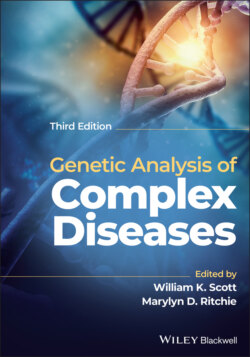Читать книгу Genetic Analysis of Complex Disease - Группа авторов - Страница 74
Example of Calculating Attributable Fraction
ОглавлениеIn a population‐based study examining the contribution of sickle cell disease to the occurrence of developmental disabilities, the Miettinen formula (Equation 3.2) was applied to demonstrate that 34% of the cases of stroke‐related developmental disabilities in black children were due to sickle cell disease (Ashley‐Koch et al. 2001). In this example, the fraction of cases with stroke‐related disabilities with the risk factor (sickle cell disease) was 0.34 (13 children with sickle cell disease among a total of 38 children with stroke‐related developmental disabilities), and the relative risk was 130. Thus, the attributable fraction by the Miettinen formula is 34% (0.34 * (129/130)).
For all the ease with the family history approach, there are several pitfalls that may occur. One should be aware that a positive family history is a function of many things, including the frequency of the condition in the general population, the size of the family, the natural history of the condition, the underlying genetic mechanism, and possibly shared environmental exposures. For example, if a condition is relatively common in the population, a positive family history may simply result from the presence of phenocopies in the family. Also, in a condition with late onset, young relatives may be misclassified as “disease‐free” (i.e. they may not express the condition simply because they are too young to express it). For example, if one is studying Alzheimer disease and finds that a 55‐year‐old sibling of an affected proband has no signs of dementia, one should re‐examine that sibling at regular intervals to determine if he/she remains asymptomatic over time. It is possible that, at the age of 55 years, the sibling is too young to express symptoms. However, if he/she were re‐examined at 60 years of age, he/she would exhibit symptoms. Thus, if the only physical examination for that sibling was performed at 55 years of age, he/she would be classified as “normal.” But if another physical examination was performed at the age of 60 years, then the individual would be classified as “affected.” Thus, whenever resources allow, follow study participants over time for changes in affection status. In addition to variation in the age of onset of a condition, there may be variable expression of the condition. Therefore, family members who have minor manifestations of the condition or are in the early stages of the disease process may not be recognized as expressing the condition. Furthermore, in complex genetic disorders, individuals in the family may not express the disorder because they possess only a fraction of the necessary genetic and environmental factors to express the condition. For all these reasons, one may want to examine the association of family history with several types of relatives in order to make sure that the same conclusion is reached for all relative types.
